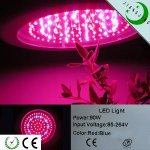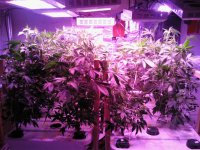My best with the foil is a picture with hair (under 1mil), good enough for any SMD.
I can get traces like this too, in fact I've managed to get the finest traces that the CAD program and printer are capable of producing, to etch out. It's not much use to anyone really, but it does highlight that both methods are quite capable of more resolution then is ever necessary.
PS - 5th , they make some VERY powerful UV led's now.
Indeed, my comment was really one of curiosity, how well will a normal warm white LED do at working the light sensitive layer on the PCB.
I do in fact have a bag of UV LEDs, the trouble I can foresee would be managing to diffuse the light well enough so that hot spots aren't created. I do wonder what kind of UV intensity is required though. It cannot be much if the 'safe' emissions that standard lamps can put out will work.
I can get traces like this too, in fact I've managed to get the finest traces that the CAD program and printer are capable of producing, to etch out. It's not much use to anyone really, but it does highlight that both methods are quite capable of more resolution then is ever necessary.
Indeed, my comment was really one of curiosity, how well will a normal warm white LED do at working the light sensitive layer on the PCB.
I do in fact have a bag of UV LEDs, the trouble I can foresee would be managing to diffuse the light well enough so that hot spots aren't created. I do wonder what kind of UV intensity is required though. It cannot be much if the 'safe' emissions that standard lamps can put out will work.
Do like the LED plant growlights , stagger blues and UV's. They actually stagger red-blues-and UV's for the gardens , it looks real close to sunlight.
They offset the angle's of the devices as well. A normal warm led (or luxeon) is confined to mostly red/longwave blue to be the most efficient in the visible spectrum. A "el cheapo" white led with the bluish hue has more longwave UV. I have a UV that you can not see
OS
PCB fabrication. - diyAudio
Nice wiki 5th element. I have tried iron on - not successful, but I guess reading ostripper's description I can work out what I did wrong. I've had a bit more success using the transparency method, but still ended up with pin holes and crap. Here the reason was I used an ink jet transparency that clearly wasn't opaque enough. I'm going to try and get myself organized again to be able to etch my own boards. It can get expensive sending them out.
Nice wiki 5th element. I have tried iron on - not successful, but I guess reading ostripper's description I can work out what I did wrong. I've had a bit more success using the transparency method, but still ended up with pin holes and crap. Here the reason was I used an ink jet transparency that clearly wasn't opaque enough. I'm going to try and get myself organized again to be able to etch my own boards. It can get expensive sending them out.
OS,
What do you use to cut the FR4 pcbs?
Solid
These things work great for that:
Dremel 114-545 - Multipurpose Diamond Wheel .016" Th. 7/8" Dia.
makes a mess though
OS,
What do you use to cut the FR4 pcbs?
Solid
Scribe both sides with a very sharp scribe and straight edge , through the copper and the first layer of two of glass epoxy. Make sure your scribes are exactly opposite each other. Place on edge of table and snap off. If you have gone deep enough , it will break off with little effort.
PS. A small metal shear would be much nicer.
OS
I use a band saw to chop up my boards.
I use a laser printer for mine and I've never had any real trouble with it. Occasionally it wont put toner down in a tiny area, creating, as you've mentioned a pin hole, but usually there's only one per design and usually this isn't in a critical area.
Back in high school I took the electronics course, and as part of that we had to build a simple project, this included making a PCB. To help with the pin hole issue we put the transparency through the printer twice, thus doubling up the thickness of the ink layer. The printer used here was a laser too.
I have tried doing this myself and it doesn't work, the transparency doesn't align itself well enough to print over the exact same area. With small SMD packages this is completely unacceptable, the spacing I use between 0.5 pitch pins is only 0.228mm, so there's no margin for error.
but still ended up with pin holes and crap. Here the reason was I used an ink jet transparency that clearly wasn't opaque enough.
I use a laser printer for mine and I've never had any real trouble with it. Occasionally it wont put toner down in a tiny area, creating, as you've mentioned a pin hole, but usually there's only one per design and usually this isn't in a critical area.
Back in high school I took the electronics course, and as part of that we had to build a simple project, this included making a PCB. To help with the pin hole issue we put the transparency through the printer twice, thus doubling up the thickness of the ink layer. The printer used here was a laser too.
I have tried doing this myself and it doesn't work, the transparency doesn't align itself well enough to print over the exact same area. With small SMD packages this is completely unacceptable, the spacing I use between 0.5 pitch pins is only 0.228mm, so there's no margin for error.
Please, watch this video friends
This demonstrate this simple software use:
YouTube - Livewire and PCB Wizard review
regards,
Carlos
This demonstrate this simple software use:
YouTube - Livewire and PCB Wizard review
regards,
Carlos
- Status
- This old topic is closed. If you want to reopen this topic, contact a moderator using the "Report Post" button.
- Home
- Amplifiers
- Solid State
- DIY home etched boards, old style, simple, fast and SMD style

